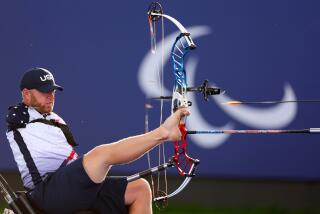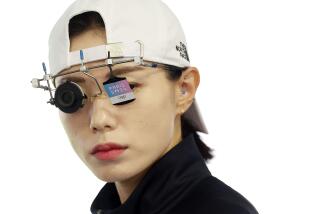Archer Sets Her Sights on ’92 Olympic Games : After 12 Years, Janet Dykman Gets New Bow, New Coach and Urge to Compete
- Share via
When she first competed as a teen-age archer while attending Arroyo High School of El Monte, Janet Dykman displayed flashes of promise.
Dykman was talented enough to earn a berth in the Junior Olympic Archery Development program and place high in numerous state and local tournaments.
But shortly after graduating from high school in 1972, Dykman left the sport.
But from time to time over the next 12 years, Dykman said, she thought about returning.
“Every once in a while I’d go back to it but I’d talk myself out of staying,” she recalled.
It was while she was a spectator at the archery competition for the 1984 Summer Olympics at El Dorado Park in Long Beach that Dykman finally decided to return.
“I got there and saw all the men and women competing and how archery had developed over the years and I decided to get back,” she said. “I was watching them and I said to myself, ‘I can do this.’ ”
Since her return, Dykman has demonstrated that point to her opponents. Last month, the 35-year-old El Monte native finished fourth in qualifying for the 1989 World Archery Target Championships July 2-9 in Lausanne, Switzerland.
She also qualified for the U.S. Olympic Sports Festival from July 18-27 in Oklahoma City, finishing fifth with a score of 1,233 points (out of a possible 1,440) in the West team trials in May.
Within the last year, she has produced a high score of 1,266. The only woman from the U.S. to surpass the 1,300 barrier in the last year is Utah’s Denise Parker with 1,314.
Meanwhile, Dykman has been making steady progress toward the 1992 Summer Olympics in Barcelona, Spain--progress that Dykman says she could have scarcely imagined when she first entertained thoughts of resuming the sport.
“I started out at home with my first bow just to see if I could still do it and then I went out and got a new one,” Dykman said.
When she finally started competing again, Dykman found that her aim was as accurate as ever.
“I found my new bow in November or December (of 1984) and I went to (a tournament in) Las Vegas in January and found it was still there,” she said. “It took me a few shots but I had a good idea (about strategy) and I was grouping real well.”
What she also realized was that the sport had changed considerably.
“When I stopped competing (in 1972) I was still shooting a one-piece wooden bow. Now they use mostly magnesium alloys,” she said. “It has just advanced so much since then.”
Perhaps, she said, that is what stopped her from returning to archery sooner.
“It was a challenge to adapt to the rules for adults and the distances and what you could and couldn’t have with your bows,” Dykman said. “That was a reason why I left. It (the sport) went through a lot of changes and I think it would have been hard to compete at that time.
She never doubted, however, that she could adjust.
“I think the basic ability was there all along,” Dykman said. “The main problem with taking a long break is the muscles you use. Getting in the right condition to work the weight (of the bows and equipment) was important.”
Dykman improved so much that she qualified for the 1988 U.S. Olympic Team trials and had hopes of making the team for the Summer Olympics in Seoul.
But she struggled to a distant 23rd and left the trials disappointed.
“My original goal was for ’92 and then things were going so well that I figured I would go for ‘88,” she said. “You go there trying to make it and you’re disappointed when you don’t.”
That was before she started training under Coach Larry Noriega of Hacienda Heights about a year ago.
“We met when we were shooting at the indoor lanes” in Monrovia, he remembered. “When I first saw her I could see that she had potential but I also knew she had some problems we had to work with.
“I knew she had to know her equipment. She had to know the basics . . . so that if it did break in a competition, she could fix it. She had that fear before when she competed. Now she doesn’t have that problem.”
Dykman was surprised at how how fast she improved in competition.
“Immediately after I started working with Larry, I noticed improvement,” she said. “He’s got me in tune with myself and my equipment. Now I know what I can do and I know what I have to do to get there.
“To me the major thing was to change my shooting form. I was shooting well before but I wasn’t getting it down there as consistently as before. Knowing the equipment has helped, too. I’m thinking more about the overall picture.”
For Dykman, the overall picture has included staying in top condition. That’s important, given the weight that an archer must carry during a typical tournament.
“She’s shooting with close to 40 pounds now and just picture a person doing that 144 times” in a typical tournament, Noriega said.
Dykman’s daily workout schedule includes aerobics, lifting weights and bicycle riding.
“When I first started with it, I thought, ‘Why do I need to lift weights?’ But now I look at it differently. . . . I knew it was good for you but I didn’t realize how important it was for leg strength when you stand in one place for a while. Plus I think it builds confidence because you feel good about yourself.”
It was this new-found confidence that Dykman said she felt during the world trials in Atlanta.
“When I went to Atlanta, I felt like I was one of them,” she said. “(Before) I would tell myself I was but by the time I got there I wasn’t. Now I feel like I have more skills and I’m a more important part of it.”
Dykman said that the most difficult part about returning to competition at first was juggling archery with her work schedule. When she started competing again, Dykman was working 60 to 70 hours a week as a manager at a ceramic production plant.
“I practically lived at that job and I liked it but it was time-consuming,” she said. It was so demanding that Dykman finally left her job and moved back home with her parents in El Monte so she could train full time for the 1988 Summer Olympics.
Hoping to defray her expenses, she has lived with her parents the last two years. Not the easiest decision for a 35-year-old to make but Dykman didn’t feel as if she had a choice.
“It was a have-to situation,” she said. “It was difficult living under that structured environment again. But it was getting pretty expensive to pay my rent and my bills and still compete.”
Dykman said moving home was just as difficult on her parents, Greta and Cornelis.
“I think it was kind of rough on my parents when I decided to leave and then when I decided to come home but they’ve been very supportive of me and my goals,” she said. “I think they felt a little better once they saw me attaining some of my goals.”
Over the last year, Dykman has been working part time at a door and window company in South Pasadena.
“They’re very willing and supportive of my goals in this sport,” she said. “When I need time off for tournaments, I just mark it off on my calendar. It’s a fantastic job.”
But even though she lives at home and has a job that fits into her training and tournament schedule, she said staying afloat financially is difficult. She said she has a trust fund at the National Archery Assn. in Colorado Springs but that covers only a small portion of her expenses.
“You’re an amateur, so you have to pay your own way most of the time,” she said. “Once you make the world team they pay your expenses. But it’s getting there that’s difficult financially.”
Dykman said finances will probably dictate how long she remains in the sport after the 1992 Summer Olympics.
Finances aside, the future would appear to be bright for Dykman.
Noriega said he has watched Dykman improve steadily since he started coaching her and has high hopes for her near future.
“My goal is to get her to break that 1,300 score,” he said. “Once we get that I think we’ll be over the top.”
Dykman believes she is taking the proper course toward making it to the Olympics.
“I’ve been doing it the right way this time,” she said. “I came back with the right people and the right organization. I am also using the right style.”
She hopes that will make all the difference between competing in the Olympics and watching from the sidelines.
More to Read
Go beyond the scoreboard
Get the latest on L.A.'s teams in the daily Sports Report newsletter.
You may occasionally receive promotional content from the Los Angeles Times.






